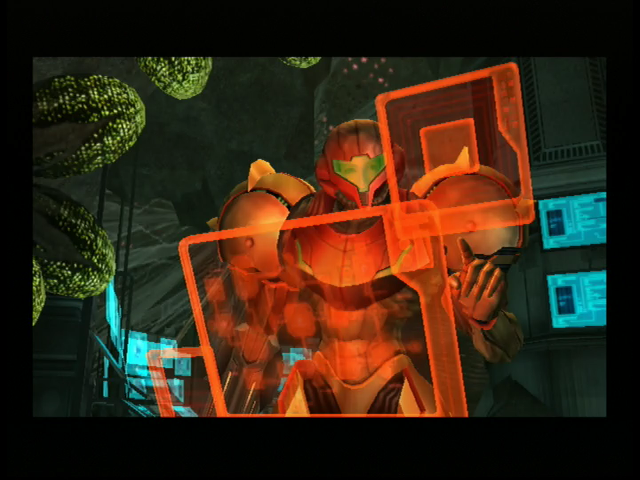Samus Works Alone

I still remember the date. Thursday, December 13, 2007.
For months afterward, I did not cry. I did spend a lot of time sleeping. I had trouble moving. What had I ever contributed to the world? Nothing. I had done nothing. I had failed at my life’s sole significant venture, and what’s more, that venture had been attaining the interest of a man. Pitiful.
My ex-boyfriend of five years had moved out. I had been forced to live with the person who I hated the most: myself. I couldn’t escape her. She was everywhere.
I knew a couple things for certain: I wanted to kill myself. And Metroid Prime 3 had just come out.
I called an anxiety clinic that I had first visited years prior; I had internalized some of what I’d learned there, but I had to go back. I could see, as though through a thick haze, that suicide didn’t make sense and that I had to get help. To make the appointment. To get a Gamefly account. To wait for my game to show up. To drag my body outside, to work, to class. To ignore the voice in my head that said I had never done anything worthwhile before now, and that I probably never would.
Just take it a day at a time.
I had never played any Metroid games before. I’d had almost exclusively male friends growing up, especially in high school and college. We played games about men, watched movies about men, and called each other “dude”. I knew who Samus was; I knew her mythology, her history. But I didn’t know the games’ premises or themes.
I’d kindled my love of shooters with Counter-Strike, and I had eventually branched out to console shooters like Call of Duty, Halo, Gears of War, and the like. I played all of the above with my ex-boyfriend, a guy that I had dated since age 16. I needed a new game. I needed a new game for me. I needed to make new memories.
Samus still represents a breakthrough. She first took off her armor to reveal a woman’s form back in 1986, the year that I was born. Samus and I grew up separately, kindred spirits who did not find one another until 2007. A best friend, a fraternal twin sister, a clone separated at birth. Or so I felt, as I let myself slip behind that visor. I wasn’t Samus myself – not yet. I stood behind her, hanging back. Did I dare? Did I dare pretend, role-play, allow myself to act as Samus? Could I be that cool?
At age 15, I fell in love – a raw, all-or-nothing kind of infatuation, the kind that feels like a new sun just popped up in your empty solar system and now you know what an orbit feels like. The guy and I finally started dating a year after that. After high school, he went to college in New York; I stayed in Boston. The relationship should’ve ended then.
I clung to his phone calls, his emails, his chat logs like a life raft.
I didn’t leave my dorm room, except for class. I stayed up all night reading comics, playing Counter-Strike, watching anime. I had plenty of time to get my coursework done and get good grades, because I didn’t make friends. I ate breakfast, lunch, and dinner alone every single day.
Meanwhile, the guy had gone from being a shy gamer nerd who wrote me romantic limericks to a confident, flippant, mustached pre-law student with more friends than I could count or even remember. By the time he moved back to Boston for graduate school, nothing felt right. Nothing had felt right for a long time, but we had lived far enough away from each other to ignore the red flags.
We moved in together anyway. Embers of resentment burned, ever so slowly, around us. He would come home each night, drunk and giddy from partying with other people. I would still be where he’d left me, sitting in the spare room, gluing together pieces of craft foam for costume armor or watching Sailor Moon. After two years of that, he dumped me.
Somehow, I didn’t see the break-up coming. I saw no alternative, besides continuing as we had been for all time. I was not happy, but I did not know why. I had a boyfriend. What else was there?
Did we not have enough sex? I remember wailing at him between sobs during the last conversation we ever had. Was this because I’ve been too busy to cook you dinner lately? Is this because of all the dishes? Because the bathroom wasn’t clean? I cringe to remember this. What did I do wrong? What was I missing?
Self-respect.
Each Metroid Prime game begins in disaster.
Samus loses her powers. Samus comes across dead bodies. Samus finds herself lost in a world unknown. Samus seeks out a power that no one understands. The power destroys all it touches. Samus must save herself. Samus must fight herself.
The theme throughout is that Samus has limitations, but that she can overcome them via ingenuity. Even if she begins by losing her powers, you know that she will find them again – that you will find them.
In Metroid Prime in particular, Samus fights against a metroid that fuses with Phazon to become an avatar … of Samus. The franchise does not adequately explain why this might occur, but the implication still feels valuable to me. Phazon, if we assume it to be an intelligent entity (as the story implies it to be), looks upon Samus as an insurmountable foe. Or, perhaps, the writers behind the story saw Samus as her own worst enemy.
In other Metroid story-lines, Samus fights Ridley (who killed her parents) and Mother Brain (who acts as a duplicitous mother figure to Samus, at least within certain canons). But, by strange coincidence, I began with the story where Samus fights against, essentially, herself.
I could understand feeling like one’s self is one’s own worst enemy. And like Samus, I had to forage for the parts for a power suit – a metaphorical one, made of alternative appraisals. The anxiety never goes away. You just learn how to cope with it. The lava never goes away. But Samus gains the strength to keep walking through it.
Recently, I’ve revisited my favorite bits and pieces of the Metroid franchise. I’ve explored the depths of Metroid Prime and Super Metroid, combed through comics and mangas, listened to the soundtracks and hummed the tunes to myself while washing dishes. It all never really went away, or at least it never went far; I kept my memories Samus’s adventures filed in the back of my head. I keep different iterations of Samus as the background images on every device I own; I let her look over my shoulder at my life, as though she is the roommate I am missing.
Back during my deep depression of 2007, I read Yoshio Sakamoto’s Metroid manga for the first time and loved the way it blended Samus’s masculine and feminine traits – her fondness for butterflies, her anger at not getting to train and fight on her own terms, her pacifism, her unrelenting determination. But looking back on the pages now, I can hardly believe how little of it I remembered. My brain picked which aspects of it to love and treasure, such as this moment with Samus curled up alone in her bed. I had done this, especially during the time at which I first read this book, back in 2007. I saw myself there on that page, then. I see myself there now, still.
A page from Metroid Manga. Source: Metroid Recon
But many of the rest of the manga’s pages – bits and pieces of which got slotted into Other M, years later – did not fit my view of Samus, such as a scene near the story’s end in which a panicking Samus faces Ridley at last and screams at the Chozo to “kill her,” to put her out of her misery. I’m not sure I saw or internalized that page, back in 2007. I had somehow wiped that image from my brain, choosing instead to remember Samus as the heroine who overcame, a woman who lived alone and grew to love it, not a woman whose misery and memory had become a cage that bound her well into her adulthood. I had gone to therapy; I had found my tools, my strategies, my coping mechanisms. I wanted the same for Samus. And in my personal canon, she finds the same tools I had.
But not everyone sees Samus the same way that I do. Even now, not everyone does, nor can.
Enough Metroid stories have been told, at this point, that contradictions exist. Which comics do we each count as part of the story? Which writers of Samus do we believe did her justice? Which parts of her mythology do we each, individually, choose to remember?
In talking to other people about Samus, I find myself taking certain traits of hers for granted. Often, I find that I can’t cite these traits in the texts provided to us about her. In some cases – in the manga, in Other M – Samus’s true canon directly contradicts the story of her life that I tell myself.
To me, that “true canon” does not matter. After all, I was Samus, for a time. I lived inside her. I pointed a blaster barrel at space pirate chests. Don’t tell me I don’t know what she was thinking – I was there, inside her head.
It’s a persona bias, I suppose, but it’s not one I have any intention of changing. I met Samus, almost by happenstance, at a crucial time. I needed to get out of my own head; I needed to believe in an alternative. I needed to know that I could be alone and that the aloneness would not destroy me. I grew to appreciate having me around. Washing my dishes – there were never any others to do. Playing my music – who could complain? Making a dinner for one – whatever dinner I liked. I grew to see these changes as victories and points of pride, instead of markers of shame or failure. This place is mine. Any success I have is mine. I work alone.
I’ve lost my power suit a few times, since then. But I always find the pieces again. I’ve done it before. I know the way.

1 Comment
Pingback: Fund the First Six Months of re/Action |